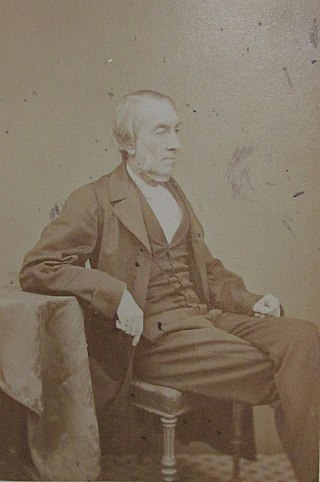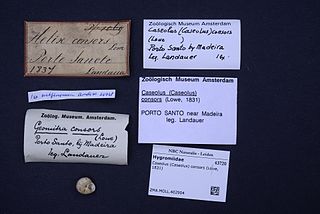Calculus in its most general sense is any method or system of calculation.

Richard Thomas Lowe (1802–1874) was an English scientist, a botanist, ichthyologist, malacologist, and a clergyman. In 1825 he graduated from Christ's College, Cambridge, and in the same year he took holy orders. In 1832 he became a clergyman in the Madeira Islands, where he was also a part-time naturalist, extensively studying the local flora and fauna. He wrote a book on the Madeiran flora. He died in 1874 when the ship he was on was wrecked off the Isles of Scilly.

Bermuda land snails, scientific name Poecilozonites, are an endemic genus of pulmonate land snail in the family Gastrodontidae. 12 species are known from the fossil record, and 4 of these species survived into modern times, but due to the highly negative effects of human development, the extant species has been reduced down to only bermudensis and circumfirmatus.

Caseolus is a genus of land snails in the family Geomitridae.
Caseolus sphaerula is a species of small land snail, a terrestrial pulmonate gastropod mollusk.
Caseolus commixtus is a species of small air-breathing land snails, terrestrial pulmonate gastropod mollusks in the family Geomitridae.

Caseolus consors is a species of small air-breathing land snails, terrestrial pulmonate gastropod mollusks in the family Geomitridae. This species is endemic to Porto Santo Island, Portugal.

Caseolus hartungi is a species of small air-breathing land snails, terrestrial pulmonate gastropod mollusks in the family Geomitridae.
Caseolus leptostictus is a species of small air-breathing land snails, terrestrial pulmonate gastropod mollusks in the family Geomitridae. This species is endemic to the Madeira island, Portugal.
Caseolus subcalliferus is a species of air-breathing land snail, a terrestrial pulmonate gastropod mollusk in the family Geometridae, the hairy snails and their allies.
Geomitra moniziana is a species of air-breathing land snail, terrestrial pulmonate gastropod mollusks in the family Geomitridae.
Leiostyla gibba is a species of small, air-breathing land snail, a terrestrial pulmonate gastropod mollusk in the family Lauriidae. This species is mentioned in Annexes II and IV of the Habitats Directive. It is one of several species sometimes referred as Madeiran land snail.
Lemniscia is a genus of air-breathing land snails, terrestrial pulmonate gastropod mollusks in the family Geomitridae, the hairy snails and their allies.
Madeiran land snail is a common name which has been given to several different species of terrestrial gastropods, air-breathing land snails:
Caseolus calvus is a species of small air-breathing land snail, terrestrial pulmonate gastropod mollusks in the family Geomitridae, the hairy snails and their allies.

Geomitridae is a taxonomic family of small to medium-sized air-breathing land snails, terrestrial pulmonate gastropod mollusks in the superfamily Helicoidea.






